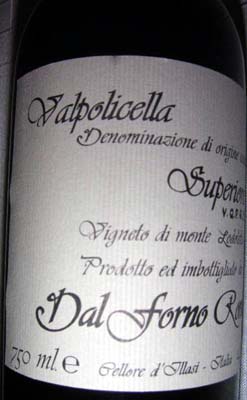Weinbach Muscat 2007, Dal Forno Valpo 2003
Posted on 4 March 2009
Tomorrow we have a themed tasting of Argentine wines, which already makes me shiver with horror at the amount of oak and extract I’ll need to inhale. Today, we went through an assorted bunch of wines from Italy and France. Among them, the
Domaine Weinbach Alsace Muscat Réserve 2007. Although it’s never been as exciting as the Riesling offerings from this stellar domaine, I expected a lot more from this. It showed very average, losing even to a cheaper Alsatian Muscat from Laurent Barth (which was really, really good). The Weinbach had a faint varietal nose (apples and grapes) over a core of cool stone, and a rather thin palate with a greenish acidity. Better as it warmed up in the glass, revealing a richer medium body and good balance. But still not the expression and cut one associates with the Weinbach name.I took the bottle home to retaste with dinner… and there was obvious TCA (cork taint). Upon opening, it was so minor as to pass unnoticed (even among a half-dozen experienced tasters), but clearly robbed the wine of freshness and complexity. This makes you think of how many faulty wines are assessed as if they weren’t…
The other noteworthy wine of today was the Romano Dal Forno Valpolicella Superiore Monte Lodoletta 2003. Dal Forno is about as high one the Italian wine hypometer as can be, but I dislike his heavy, showy style and interventionist winemaking. Still, given the prices and recognition these wines command, it is also worthwhile to taste them when an occasion arises.
This wine is an amarone in all but name. It smells of prunes, stewed cherries, tobacco, chocolate and spices, and has 15% alcohol. It is to the best of my knowledge made of dried grapes like amarone, and is priced higher than almost all amarones (73€ here in Poland at the current exchange rate). So why call it a Valpolicella? For Dal Forno, it is his ‘second label’ or ‘second selection’ wine: perfect grapes go into his Amarone, and less-than-perfect ones go here. But if you don’t know about this curious policy, you’d be nonplussed by this.

Is this 2003 a good amarone? No. There is far too much extraction and new oak for good balance. The wine smells stewed, tasted stewed and finishes dry-tannic. There is no freshness or finesse, and the fruit is dead. Amarone comes in various guises; I like the more vinous, crisp, less sweet style, and you might like the richer, more powerful one, but balance is the key to success in both. This wine is unbalanced. It tries to impress with its sheer power but goes far too much in the extraction.
Will it ever integrate? We left it in the decanter overnight to see. But predictably, it only got worse. Whatever little freshness of fruit was there upon opening was gone; all that was left was alcohol and oak tannins. Admittedly, it didn’t oxidise even with 18 hours in the decanter. But there was no drinking pleasure. Even the label drinkers among us were skeptical.

